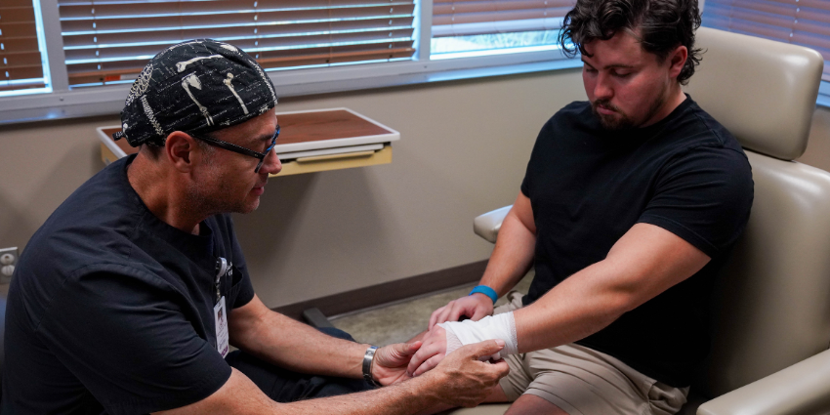
Wound Care
For those who suffer with chronic or non-healing wounds, help is as close as the Norman Regional Oklahoma Wound Center®. Our specialized treatment and comprehensive approach helps heal wounds that have resisted other treatments. If you have sores or wounds that have not improved during the course of conventional treatment, Norman Regional Oklahoma Wound Center is the place to be.
The Oklahoma Wound Center is dedicated to the support and treatment of patients with chronic, non-healing wounds. Our team of experts include board-certified physicians, experienced wound care nurses, and certified hyperbaric specialists.
We offer
- Comprehensive care
- Patient and family education about their wound treatments
- Circulation screening tests
- Specialized dressings including negative pressure therapy, total contact castings, biologic alternative tissue applications, and compression wraps
- Hyperbaric Oxygen Therapy
The doctors and staff at the Oklahoma Wound Center will provide you with special treatment plans. The plans will help heal your wound as quickly as possible. You may need tests that will tell us more about your wound. You will also be taught how you can prevent new wounds.
Hyperbaric Oxygen Therapy
Hyperbaric Oxygen Therapy involves the patient breathing 100% oxygen in a pressurized chamber. The increased oxygen in the blood leads to more oxygen in the wound which leads to increased healing.
What is Hyperbaric Oxygen Treatment like?
It is not painful. Patients lie in the chamber and may watch television
or movies, communicate with staff, drink water or even nap during the
treatment. With four brand new individualized Hyperbaric Oxygen Therapy
chambers, the Oklahoma Wound Center is able to provide Hyperbaric Oxygen
Treatment for up to four patients at one time.
Certified Hyperbaric Oxygen Therapy technicians
Norman Regional's Oklahoma Wound Center has certified Hyperbaric Oxygen
Therapy technicians.
Our technicians administer Hyperbaric Oxygen Therapy to patients as prescribed by a hyperbaric physician. In addition to passing a strenuous exam, our certified technicians have completed a 40-hour introductory hyperbaric medicine course, a minimum of 500 hours of clinical hyperbaric training, as well as verified and endorsed core competencies in Hyperbaric Therapy.
Watch the video below to learn more about Hyperbaric Oxygen Therapy.
People who may benefit from the specialized care at the Oklahoma Wound Center include those with:
- Diabetic wounds
- Neuropathic wounds
- Pressure ulcers
- Ischemic ulcers
- Traumatic wounds
- Burns
- Surgical wounds
- Venous insufficiency ulcers
- Post-radiation wounds
Location and hours
The Oklahoma Wound Center is located inside the Heart Plaza medical building located off Interstate 35 and Tecumseh Road, on the Norman Regional Hospital campus.
We are open from 8 a.m. to 5:00 p.m. Monday through Friday.
If you have any questions or would like to schedule an appointment, please give us a call at 405-307-6955.
For providers
A patient who has chronic or non-healing wounds that have not improved during the course of conventional treatment may benefit from the specialized wound care provided at the Oklahoma Wound Center.
Is Hyperbaric Oxygen Therapy right for your patient?
Hyperbaric Oxygen Therapy:
- Treats Ischemia by increasing the p02 in tissues
- Stimulates Angiogenesis
- Decreases Inflammation
- Breaks the dangerous cycle of [Ischemia > Inflammation > Tissue Necrosis > Ischemia] Seen in:
- Reperfusion Injury
- Crush Injury
- Compartment Syndrome
- Acute Arterial Occlusion
- Stimulates Bone Healing
- Increases fibroblasts which increase collagen
- Augments certain antibiotic effectiveness
- Improves cell and capillary growth in irradiated tissues
Transcutaneous Oxygen Measurement (TCOM or TcPO2)
This noninvasive test of the extremity measures tissue oxygen pressures
in different conditions (Room air, supplemental oxygen, and extremity
elevation). It assesses if ischemia will hinder healing, so further vascular
evaluation can be done. TCOMs predict the likelihood of healing certain
amputation levels so that the most distal amputation can be planned. The
results may be used to gauge how responsive tissue is to Hyperbaric Oxygen therapy.
Ratings and Comments




